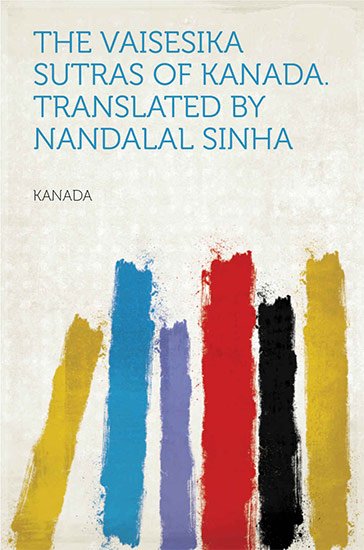Vaisheshika-sutra with Commentary
by Nandalal Sinha | 1923 | 149,770 words | ISBN-13: 9789332869165
The Vaisheshika-sutra 7.1.7, English translation, including commentaries such as the Upaskara of Shankara Mishra, the Vivriti of Jayanarayana-Tarkapanchanana and the Bhashya of Chandrakanta. The Vaisheshika Sutras teaches the science freedom (moksha-shastra) and the various aspects of the soul (eg., it's nature, suffering and rebirth under the law of karma). This is sutra 7 (‘colour, etc., of earth, produced by burning, continued’) contained in Chapter 1—Of Colour, Taste, Smell, and Touch, and Magnitude—of Book VII (of the examination of attributes and of combination).
Sūtra 7.1.7 (Colour, etc., of Earth, produced by burning, continued)
Sanskrit text, Unicode transliteration, Word-for-word and English translation of Vaiśeṣika sūtra 7.1.7:
एकद्रव्यत्वात् ॥ ७.१.७ ॥
ekadravyatvāt || 7.1.7 ||
eka-dravya-tvāt—Because of the characteristic of inhering in one substance.
7. Because their substratum is the same.
Commentary: The Upaskāra of Śaṅkara Miśra:
(English rendering of Śaṅkara Miśra’s commentary called Upaskāra from the 15th century)
In order to establish that the Colour, etc., of terrene ultimate atoms have conjunction of fire as their non-combinative cause, he says:
[Read sūtra 7.1.7 above]
The expression, “of (attributes) produced from burning,” is the complement of the aphorism. “Being attributes,” and “being effects,” are also intended here. The whole sentence, therefore, means: Colour, etc., of terrene ultimate atoms, have conjunction for their non-combinative cause, inasmuch as these, being product-attributes, are at the same time non-abhorrent or incongruent attributes inhering in eternals, like Sound, and like Understanding, etc. Or the sādhya, or what has to be proved, is merely the characteristic of being produced from conjunction. Hence there is no undue extension to, or inclusion of, Sound produced from disjunction, since conjunction of Air is the efficient cause of all Sounds whatever. And from the observation of the presence and absence of fire in relation to them, the non-combinative causality of conjunction of fire, towards terrene colour, etc-, is proved by the force of pakṣa-dharmatā i.e., the characteristic of the vyāpya or the middle term, the mark of inference, existing in the pakṣa or the subject of the conclusion.—7.
Commentary: The Vivṛti of Jayanārāyaṇa:
(English extracts of Jayanārāyaṇa Tarkapañcānana’s Vivṛti or ‘gloss’ called the Kaṇādasūtravivṛti from the 17th century)
The question may arise, how the attributes of the cause, as they do not exist in the effect, can be productive of the attributes of the effect, when there is thus a difference of substrata. Apprehending this, he says:
Because they have one substance as their substratum, that is to say, because there is co-existence in the same substratum. Thus, even though the attributes of the cause do not exist in the effect by the relation of immediate combination, yet, inasmuch as they exist in the effect by the relation of co-existence in the same substratum in the form of combination with that which is in combination with them, their productiveness of the attributes of the effect is not unproved. This is the import.
